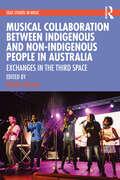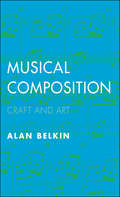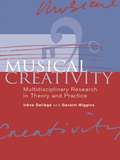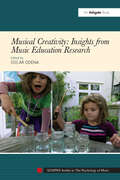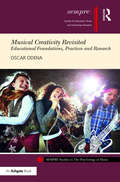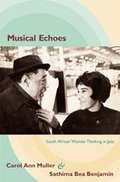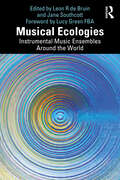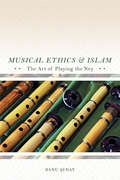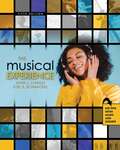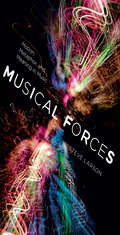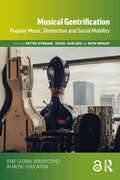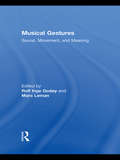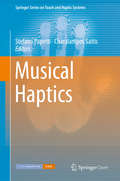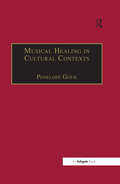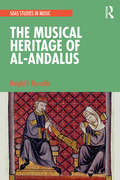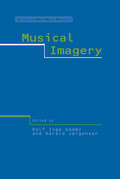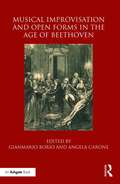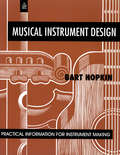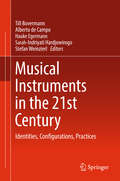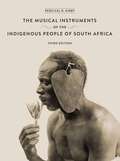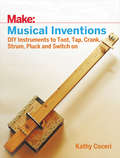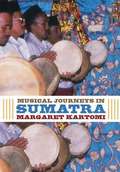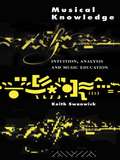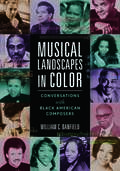- Table View
- List View
Musical Collaboration Between Indigenous and Non-Indigenous People in Australia: Exchanges in The Third Space (SOAS Studies in Music)
by Katelyn BarneyThis book demonstrates the processes of intercultural musical collaboration and how these processes contribute to facilitating positive relationships between Indigenous and non-Indigenous peoples in Australia. Each of the chapters in this edited collection examines specific examples in diverse contexts, and reflects on key issues that underpin musical exchanges, including the benefits and challenges of intercultural music making. The collection demonstrates how these musical collaborations allow Indigenous and non-Indigenous people to work together, to learn from each other, and to improve and strengthen their relationships. The metaphor of the “third space” of intercultural music making is interwoven in different ways throughout this volume. While focusing on Indigenous Australian/non-Indigenous intercultural musical collaboration, the book will be of interest globally as a resource for scholars and postgraduate students exploring intercultural musical communication in countries with histories of colonisation, such as New Zealand and Canada.
Musical Composition: Craft and Art
by Alan BelkinAn invaluable introduction to the art and craft of musical composition from a distinguished teacher and composerThis essential introduction to the art and craft of musical composition is designed to familiarize beginning composers with principles and techniques applicable to a broad range of musical styles, from concert pieces to film scores and video game music. The first of its kind to utilize a style-neutral approach, in addition to presenting the commonly known classical forms, this book offers invaluable general guidance on developing and connecting musical ideas, building to a climax, and other fundamental formal principles. It is designed for both classroom use and independent study.
Musical Creativity: Multidisciplinary Research in Theory and Practice
by Irène Deliège Geraint A. WigginsThis collection initiates a resolutely interdisciplinary research dynamic specifically concerning musical creativity. Creativity is one of the most challenging issues currently facing scientific psychology and its study has been relatively rare in the cognitive sciences, especially in artificial intelligence. This book will address the need for a coherent and thorough exploration. Musical Creativity: Multidisciplinary Research in Theory and Practice comprises seven sections, each viewing musical creativity from a different scientific vantage point, from the philosophy of computer modelling, through music education, interpretation, neuroscience, and music therapy, to experimental psychology. Each section contains discussions by eminent international specialists of the issues raised, and the book concludes with a postlude discussing how we can understand creativity in the work of eminent composer, Jonathan Harvey. This unique volume presents an up-to-date snapshot of the scientific study of musical creativity, in conjunction with ESCOM (the European Society for the Cognitive Sciences of Music). Describing many of the different aspects of musical creativity and their study, it will form a useful springboard for further such study in future years, and will be of interest to academics and practitioners in music, psychology, cognitive science, artificial intelligence, neuroscience and other fields concerning the study of human cognition in this most human of behaviours.
Musical Creativity: Insights From Music Education Research (SEMPRE Studies in The Psychology of Music)
by Oscar OdenaHow do we develop musical creativity? How is musical creativity nurtured in collaborative improvisation? How is it used as a communicative tool in music therapy? This comprehensive volume offers new research on these questions by an international team of experts from the fields of music education, music psychology and music therapy. The book celebrates the rich diversity of ways in which learners of all ages develop and use musical creativity. Contributions focus broadly on the composition/improvisation process, considering its conceptualization and practices in a number of contexts. The authors examine how musical creativity can be fostered in formal settings, drawing examples from primary and secondary schools, studio, conservatoire and university settings, as well as specialist music schools and music therapy sessions. These essays will inspire readers to think deeply about musical creativity and its development. The book will be of crucial interest to music educators, policy makers, researchers and students, as it draws on applied research from across the globe, promoting coherent and symbiotic links between education, music and psychology research.
Musical Creativity in Restoration England
by Rebecca HerissoneMusical Creativity in Restoration England is the first comprehensive investigation of approaches to creating music in late seventeenth-century England. Understanding creativity during this period is particularly challenging because many of our basic assumptions about composition - such as concepts of originality, inspiration and genius - were not yet fully developed. In adopting a new methodology that takes into account the historical contexts in which sources were produced, Rebecca Herissone challenges current assumptions about compositional processes and offers new interpretations of the relationships between notation, performance, improvisation and musical memory. She uncovers a creative culture that was predominantly communal, and reveals several distinct approaches to composition, determined not by individuals, but by the practical function of the music. Herissone's new and original interpretations pose a fundamental challenge to our pre-conceptions about what it meant to be a composer in the seventeenth century and raise broader questions about the interpretation of early modern notation.
Musical Creativity Revisited: Educational Foundations, Practices and Research (SEMPRE Studies in The Psychology of Music)
by Oscar OdenaHow is creativity understood and facilitated across music education settings? What is the power of creativity in enhancing individual and group learning? How is musical creativity used as a tool for cross-community integration? How can we research the interactions of those engaged in musical activities aimed at creative development? These are just some of the questions addressed in this fascinating new monograph. Musical Creativity Revisited is an authoritative volume of insights from theory, practice-based research and methodological analyses. Its chapters celebrate the diversity of the many different ways in which young and adult learners develop musical creativity. Following on from Musical Creativity: Insights from Music Education Research (Ashgate, 2012) Odena offers novel examples from practice and precise suggestions on how to research it. This book will be an essential point of reference for students, researchers, practitioners and practitioner-researchers interested in music education and creativity across the arts and social sciences. The chapters have been organized into three sections – Foundations, Practices and Research – including examples from in-depth studies focussed on a secondary school in England, higher music education in Spain and out-of-school settings in Northern Ireland. This is a book that will fascinate readers, inspiring them to think deeply about the many different ways in which musical creativity can be developed, its purposes and how to research it.
Musical Echoes: South African Women Thinking in Jazz
by Sathima Bea Benjamin Carol Ann MullerMusical Echoes tells the life story of the South African jazz vocalist Sathima Bea Benjamin. Born in Cape Town in the 1930s, Benjamin came to know American jazz and popular music through the radio, movies, records, and live stage and dance band performances. She was especially moved by the voice of Billie Holiday. In 1962 she and Dollar Brand (Abdullah Ibrahim) left South Africa together for Europe, where they met and recorded with Duke Ellington. Benjamin and Ibrahim spent their lives on the move between Europe, the United States, and South Africa until 1977, when they left Africa for New York City and declared their support for the African National Congress. In New York, Benjamin established her own record company and recorded her music independently from Ibrahim. Musical Echoes reflects twenty years of archival research and conversation between this extraordinary jazz singer and the South African musicologist Carol Ann Muller. The narrative of Benjamin's life and times is interspersed with Muller's reflections on the vocalist's story and its implications for jazz history.
Musical Ecologies: Instrumental Music Ensembles Around the World
by de Bruin, Leon R Jane SouthcottCommunity music around the world reflects the growing and diverse ways humans collectivise and express themselves in ways that articulate our cultural, social, and environmental complexity. Revisiting, redevising, and reimagining some of the field’s approaches, ideologies, and contexts, this co-edited volume investigates beyond generalist intercultural and internationalist concepts to reveal the complexity of social ways people come together to make music and to making music be central to this sociality.The authors explore the role community music plays out around the world and how various instrumentally based music-making communities operate as ecologies that allow notions of social, political, and cultural agency and identity/ies. Chapters cover various instrumental community music ensembles, observing how they, as social microcosms of change and stasis, provide working methods new and old, extol values, and model ethical behaviours that are fluid and dynamic, steadfast and unyielding, and that contribute to the ebb and flow of people and their agency that remains under-researched. Insights are provided on variously functioning ensembles throughout the world, showing how myriad instrumental music communities act as drivers, complex environments, and apparati for musical and social expression that accommodates the musical aspirations of their members.Taken as a whole, this book explores community music as local, glocal, global phenomena, critically discussing the redefinition of community music and what music-making means to people in the twenty-first century.
Musical Ethics and Islam: The Art of Playing the Ney
by Banu SenayAfter the establishment of the Turkish Republic, Turkey's secularized society disdained the ney, the Sufi reed flute long associated with Islam. The instrument's remarkable revival in today's cities has inspired the creation of teaching and learning sites that range from private ney studios to cultural and religious associations and from university clubs to mosque organizations. Banu Şenay documents the years-long training required to become a neyzen—a player of the ney. The process holds a transformative power that invites students to create a new way of living that involves alternative relationships with the self and others, changing perceptions of the city, and a dedication to craftsmanship. Şenay visits reed harvesters and travels from studios to workshops to explore the practical processes of teaching and learning. She also becomes an apprentice ney-player herself, exploring the desire for spirituality that encourages apprentices and masters alike to pursue ney music and its scaffolding of Islamic ethics and belief.
The Musical Experience
by John Chiego Joel S. SchnackelThe Musical Experience is a seamlessly integrated enhanced learning package that features a thematic approach to music appreciation - each theme is described along a historical timeline. Whether it is Music to Celebrate, Music from the Stage, or Music for Mourning, the reader will associate the music presented in The Musical Experience with a life moment - enhancing the experience! To resonate with today’s music appreciation students and instructors, John Chiego has updated The Musical Experience with contemporary examples of musical selections, musicals, and music from the movies since 2000. To meet the evolving needs of music appreciation students and instructors, John Chiego has integrated:: Features an easy-to-read conversational writing style that is suitable for students with diverse backgrounds and experience. Multiple delivery options! This complete course package with a print/eBook text and optional online music library and accompanying website supplements make it ideal for face-to-face, hybrid, and distance learning settings. Real-time assessments throughout! Biographical Spotlights, Listening Exercise questions, chapter question assignments, and What Makes Music features provide gradable components that can be completed by the reader on an ongoing basis throughout the semester. Includes Interactive Listening Charts that help readers with historical periods, genre, type of piece, and composer. Encourages self discovery! Students can access accompanying textbook playlists on the optional online music as well as create their own lists to expand their own listening library.
Musical Forces
by Steve LarsonSteve Larson drew on his 20 years of research in music theory, cognitive linguistics, experimental psychology, and artificial intelligence--as well as his skill as a jazz pianist--to show how the experience of physical motion can shape one's musical experience. Clarifying the roles of analogy, metaphor, grouping, pattern, hierarchy, and emergence in the explanation of musical meaning, Larson explained how listeners hear tonal music through the analogues of physical gravity, magnetism, and inertia. His theory of melodic expectation goes beyond prior theories in predicting complete melodic patterns. Larson elegantly demonstrated how rhythm and meter arise from, and are given meaning by, these same musical forces.
Musical Gentrification: Popular Music, Distinction and Social Mobility (ISME Global Perspectives in Music Education Series)
by Sidsel Karlsen Ruth Wright Petter DyndahlMusical Gentrification is an exploration of the role of popular music in processes of socio-cultural inclusion and exclusion in a variety of contexts. Twelve chapters by international scholars reveal how cultural objects of relatively lower status, in this case popular musics, are made objects of acquisition by subjects or institutions of higher social status, thereby playing an important role in social elevation, mobility and distinction. The phenomenon of musical gentrification is approached from a variety of angles: theoretically, methodologically and with reference to a number of key issues in popular music, from class, gender and ethnicity to cultural consumption, activism, hegemony and musical agency. Drawing on a wide range of case studies, empirical examples and ethnographic data, this is a valuable study for scholars and researchers of Music Education, Ethnomusicology, Cultural Studies and Cultural Sociology.
Musical Gestures: Sound, Movement, and Meaning
by Rolf Inge Godøy Marc LemanWe experience and understand the world, including music, through body movement–when we hear something, we are able to make sense of it by relating it to our body movements, or form an image in our minds of body movements. Musical Gestures is a collection of essays that explore the relationship between sound and movement. It takes an interdisciplinary approach to the fundamental issues of this subject, drawing on ideas, theories and methods from disciplines such as musicology, music perception, human movement science, cognitive psychology, and computer science.
Musical Haptics (Springer Series on Touch and Haptic Systems)
by Stefano Papetti Charalampos SaitisThis open access book offers an original interdisciplinary overview of the role of haptic feedback in musical interaction. Divided into two parts, part I examines the tactile aspects of music performance and perception, discussing how they affect user experience and performance in terms of usability, functionality and perceived quality of musical instruments. Part II presents engineering, computational, and design approaches and guidelines that have been applied to render and exploit haptic feedback in digital musical interfaces. Musical Haptics introduces an emerging field that brings together engineering, human-computer interaction, applied psychology, musical aesthetics, and music performance. The latter, defined as the complex system of sensory-motor interactions between musicians and their instruments, presents a well-defined framework in which to study basic psychophysical, perceptual, and biomechanical aspects of touch, all of which will inform the design of haptic musical interfaces. Tactile and proprioceptive cues enable embodied interaction and inform sophisticated control strategies that allow skilled musicians to achieve high performance and expressivity. The use of haptic feedback in digital musical interfaces is expected to enhance user experience and performance, improve accessibility for disabled persons, and provide an effective means for musical tuition and guidance.
Musical Healing in Cultural Contexts
by Penelope GoukHow do people use music to heal themselves and others? Are the healing powers of music universal or culturally specific? The essays in this volume address these two central questions as to music‘s potential as a therapeutic source. The contributors approach the study of music healing from social, cultural and historical backgrounds, and in so doing provide perspectives on the subject which complement the wealth of existing literature by practitioners. The forms of music therapy explored in the book exemplify the well-being that can be experienced as a result of participating in any type of musical or artistic performance. Case studies include examples from the Bolivian Andes, Africa and Western Europe, as well as an assessment of the role of Islamic traditions in Western practices. These case studies introduce some new, and possibly unfamiliar models of musical healing to music therapists, ethnomusicologists and anthropologists. The book contributes to our understanding of the transformative and healing roles that music plays in different societies, and so enables us better to understand the important part music contributes to our own cultures.
The Musical Heritage of Al-Andalus (SOAS Studies in Music)
by Dwight ReynoldsThe Musical Heritage of Al-Andalus is a critical account of the history of Andalusian music in Iberia from the Islamic conquest of 711 to the final expulsion of the Moriscos (Spanish Muslims converted to Christianity) in the early 17th century. This volume presents the documentation that has come down to us, accompanied by critical and detailed analyses of the sources written in Arabic, Old Catalan, Castilian, Hebrew, and Latin. It is also informed by research the author has conducted on modern Andalusian musical traditions in Morocco, Algeria, Tunisia, Egypt, Lebanon and Syria. While the cultural achievements of medieval Muslim Spain have been the topic of a large number of scholarly and popular publications in recent decades, what may arguably be its most enduring contribution – music – has been almost entirely neglected. The overarching purpose of this work is to elucidate as clearly as possible the many different types of musical interactions that took place in medieval Iberia and the complexity of the various borrowings, adaptations, hybridizations, and appropriations involved.
Musical Imagery
by Rolf Inge Godøy, Rolf Inge Harald JørgensenAn edited collection of papers which explore a large number of topics related to musical imagery. Musical imagery can be defined as our mental capacity for imagining sound in the absence of a directly-audible sound source, meaning that we can recall and re-experience or even invent new musical sound through our inner ear. The first part of the volume is focused on theoretical issues such as the history, epistemology, neurological bases, and cognitive models of musical imagery. The second part presents various applications of musical imagery in performance and composition, and provides the reader with a broad overview of the many musical activities which are concerned with musical imagery.;Musical imagery is a truly interdisciplinary subject, and it is the belief of the editors that a plurality of approaches, ranging from the introspective and philosophical to the experimental and computational, is the most fruitful strategy for exploring the subject of musical imagery.
Musical Improvisation and Open Forms in the Age of Beethoven
by Gianmario Borio Angela CaroneImprovisation was a crucial aspect of musical life in Europe from the late eighteenth century through to the middle of the nineteenth, representing a central moment in both public occasions and the private lives of many artists. Composers dedicated themselves to this practice at length while formulating the musical ideas later found at the core of their published works; improvisation was thus closely linked to composition itself. The full extent of this relation can be inferred from both private documents and reviews of concerts featuring improvisations, while these texts also inform us that composers quite often performed in public as both improvisers and interpreters of pieces written by themselves or others. Improvisations presented in concert were distinguished by a remarkable degree of structural organisation and complexity, demonstrating performers’ consolidated abilities in composition as well as their familiarity with the rules for improvising outlined by theoreticians.
Musical Instrument Design: Practical Information for Instrument Making (Sound Design Ser.)
by Bart Hopkin John ScovilleThis is an encyclopedic, large-format book containing hundreds of illustrations. While not geared toward making conventional instruments, Musical Instrument Design provides all the information that anyone (amateur or professional) should ever need to construct an amazingly wide variety of percussion, string, and wind instruments. Includes many designs along with parts lists and detailed construction instructions.
Musical Instruments in the 21st Century
by Till Bovermann Alberto De Campo Hauke Egermann Sarah-Indriyati Hardjowirogo Stefan WeinzierlBy exploring the many different types and forms of contemporary musical instruments, this book contributes to a better understanding of the conditions of instrumentality in the 21st century. Providing insights from science, humanities and the arts, authors from a wide range of disciplines discuss the following questions: #65533; What are the conditions under which an object is recognized as a musical instrument? #65533; What are the actions and procedures typically associated with musical instruments? #65533; What kind of (mental and physical) knowledge do we access in order to recognize or use something as a musical instrument? #65533; How is this knowledge being shaped by cultural conventions and temporal conditions? #65533; How do algorithmic processes 'change the game' of musical performance, and as a result, how do they affect notions of instrumentality? #65533; How do we address the question of instrumental identity within an instrument's design process? #65533; What properties can be used to differentiate successful and unsuccessful instruments? Do these properties also contribute to the instrumentality of an object in general? What does success mean within an artistic, commercial, technological, or scientific context?
Musical Instruments of the Indigenous People of South Africa
by Percival KirbyPercival Kirby was a musician and ethnomusicologist and for many years head of the music department at the University of the Witwatersrand, Johannesburg. Between 1923 and 1933 he undertook more than nine expeditions as well as many shorter excursions around South Africa. He was hosted by local chiefs and taught to play the instruments he encountered. He managed to purchase many of them, and this collection, now known as the Kirby Collection, is housed at the South African College of Music, University of Cape Town. First published as Musical Instruments of the Native Races of South Africa in 1934, the book was the culmination of research trips undertaken by Percival Kirby. It became the standard reference on indigenous South African musical instruments. The bulk of the material is concerned with detailed information on the making and playing of each instrument, and is accompanied by a large number of musical examples. This third edition contains an introduction by Mike Nixon, Head of the Ethnomusicology and African Music at the South African College of Music, and new reproductions of the valuable historic photographs, but leaves Kirby?s original text unchanged.
Musical Inventions: DIY Instruments to Toot, Tap, Crank, Strum, Pluck, and Switch On
by Kathy CeceriPeople have been playing music on homemade instruments for thousands of years. But creating new instruments is much more than an art form. When you want to make a note sound higher or lower, you have to change the sound waves coming out of the instrument. That's science! When you explore the way different materials produce different sounds, that's engineering. When you speed up or slow down a song, you're counting beats -- using math. And technology makes electronic instruments and devices to record and play back music possible.
Musical Journeys in Sumatra
by Margaret KartomiDespite being the sixth largest island in the world and home to an estimated 44 million Indonesians, Sumatra's musical arts and cultures have not been the subject of a book-length study until now. Documenting and explaining the ethnographic, cultural, and historical contexts of Sumatra's performing arts, Musical Journeys in Sumatra also traces the changes in their style, content, and reception from the early 1970s onward. Having dedicated thirty years of scholarship to exploring the rich and varied music of Sumatran provinces, Margaret Kartomi provides a fascinating ethnographic record of vanishing musical genres, traditions, and practices that have become deeply compromised by the pressures of urbanization, rural poverty, and government policy in. This unique collection showcases the complex diversity of Indonesian music and includes field observations from five different provinces: Aceh, North Sumatra, Riau, West Sumatra, and South Sumatra. Featuring unique photographs and original drawings from Kartomi's field observations of instruments and performances, Musical Journeys in Sumatra provides a comprehensive musical introduction to this neglected, very large island, with its hundreds of ethno-linguistic-musical groups.
Musical Knowledge: Intuition, analysis and music education
by Prof Keith Swanwick Keith SwanwickThe understanding of music involves the mastery of its various layers of meaning. Sometimes this meaning can be acquired through human insight; at other times, it can be learned. The central concern of Musical Knowledge is the tension between intuitive and analytical ways of making sense of the world. Keith Swanwick examines this relationship on three levels: in considering music as a way of knowing; as the apparent predicament between qualitative and quantitative research paradigms; and as a tension in education. Keith Swanwick guides his reader from a theoretical exploration of musical knowledge, through an examination of ways of researching the musical experience to a concluding section which will be of direct practical help to teachers. He suggests ways in which music education can be a vital transaction, giving examples across a range of music teaching, including school classroom and instrumental studios. The book will be of interest to anyone who makes or responds to music.
Musical Landscapes in Color: Conversations with Black American Composers (Music in American Life)
by William C. BanfieldNow available in paperback, William C. Banfield’s acclaimed collection of interviews delves into the lives and work of forty-one Black composers. Each of the profiled artists offers a candid self-portrait that explores areas from training and compositional techniques to working in a exclusive canon that has existed for a very long time. At the same time, Banfield draws on sociology, Western concepts of art and taste, and vernacular musical forms like blues and jazz to provide a frame for the artists’ achievements and help to illuminate the ongoing progress and struggles against industry barriers. Expanded illustrations and a new preface by the author provide invaluable added context, making this new edition an essential companion for anyone interested in Black composers or contemporary classical music. Composers featured: Michael Abels, H. Leslie Adams, Lettie Beckon Alston, Thomas J. Anderson, Dwight Andrews, Regina Harris Baiocchi, David Baker, William C. Banfield, Ysaye Maria Barnwell, Billy Childs, Noel DaCosta, Anthony Davis, George Duke, Leslie Dunner, Donal Fox, Adolphus Hailstork, Jester Hairston, Herbie Hancock, Jonathan Holland, Anthony Kelley, Wendell Logan, Bobby McFerrin, Dorothy Rudd Moore, Jeffrey Mumford, Gary Powell Nash, Stephen Newby, Coleridge-Taylor Perkinson, Michael Powell, Patrice Rushen, George Russell, Kevin Scott, Evelyn Simpson-Curenton, Hale Smith, Billy Taylor, Frederick C. Tillis, George Walker, James Kimo Williams, Julius Williams, Tony Williams, Olly Wilson, and Michael Woods
